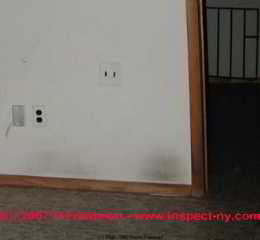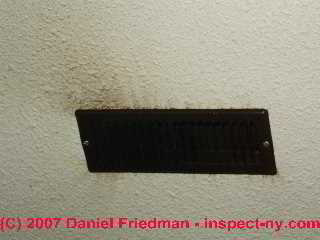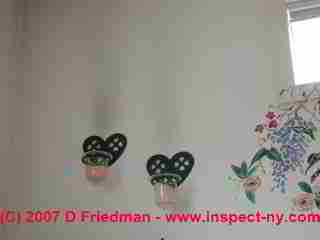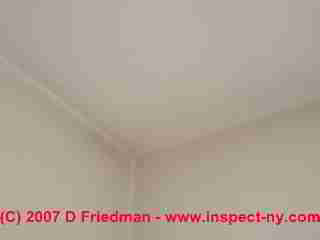 Indoor Wall or Ceiling Stains Mistaken for Ghosting
Indoor Wall or Ceiling Stains Mistaken for Ghosting
Building stains from other causes than thermal tracking
- POST a QUESTION or COMMENT about indoor stains and thermal tracking or ghosting on walls and ceilings
Indoor stains in buildings mistaken for thermal tracking or ghosting:
Making note of the size, shape, location an d pattern of indoor stains can quickly sort out the probable cause of the staining. This article provides examples of indoor stains on walls or ceilings that some readers mistook for thermal tracking or ghosting.
This article series describes & diagnoses the cause of various interior wall and ceiling stains and explains how to recognize thermal tracking, (also called ghosting or ghosting stains or thermal bridging stains), building air leaks, and building insulation defects.
InspectAPedia tolerates no conflicts of interest. We have no relationship with advertisers, products, or services discussed at this website.
- Daniel Friedman, Publisher/Editor/Author - See WHO ARE WE?
Examples of Stains that are NOT Thermal Tracking, Bridging or Ghosting
Dirty HVAC duct work, lack of air filter maintenance, or furnace malfunctions can all be indicated by black stains that appear around warm or cool air delivery registers in building ceilings or walls.
(This is usually a deposition of house dust, rarely is it mold, and rarely is it related to thermal tracking.
details about these stains at registers are given
In buildings where pets are or have been housed, smudge marks on walls and at doors and door trim are sometimes mistaken for thermal tracking - they are not.
See STAINS ANIMAL / PETS in BUILDINGS for details.
Below are stains that do appear in regular lines but are mapped to the use of candles, particularly scented candles.
We welcome more thermal tracking, soot tracking, air bypass leaks, and similar photos of indoor stains as well as text suggestions to expand this detail and would be glad to credit contributors.
What about the parallel wall stains in the photo just below? The parallel wall stains in the photograph below were in a series of interior wall & ceiling stain photographs submitted by a reader and discussed
at THERMAL TRACKING GHOSTING FAQs
Parallel dark stains on walls that are not thermal tracking:
what about the photograph just above? I think these are not thermal tracking stains, for the following reasons:
- The stains are too close together
to mark typical wall-stud framing. Wall stud spacing on 16" or 24" centers are one of the most common explanation (or part of the explanation) of the spacing of parallel stains on walls. - The stains on this wall are behind a light source
shining up through the hallway guardrail balusters and the angle of light from below, visible on the right hand wall in the photo suggests that the primary light source for this photo was from below - explaining why the "baluster shadows" are so high on the wall.
Use this link CONTACT us to send images.
...
Reader Comments, Questions & Answers About The Article Above
Below you will find questions and answers previously posted on this page at its page bottom reader comment box.
Reader Q&A - also see RECOMMENDED ARTICLES & FAQs
Question: thermal tracking on garage ceiling caused by car exhaust?
(Oct 2, 2014) Sam said:
Wow, what a great resource, thank you so much for all the info!
Question: Garage ceiling has this tracking at all the drywall seams. I can see that the ceiling was insulated.
Dark spots exactly correspond with the 12" joint compound finishing knife. Could it be that the compound was simply not sealed properly when it was painted? Also, could exhaust from cars cause this-it's nowhere else in the house.
Thanks, I love this site!
Reply:
Sam
I don't think so. More likely the joints are over studs, pipes, or cooler surfaces that pick up a bit more moisture and thus particle deposits thus stains.
Yes car exhaust could be a particle source, also a moisture source. And if the car is burning oil and is left running for some time in the garage these effects would be increased.
Watch out: for potentially fatal carbon monoxide hazards if car exhaust can enter the home or accumulate in the garage.
Question:
(Jan 17, 2012) John Dabbs said:
A friend has black deposits appearing evenly on vertical surfaces at the top of an internal lounge wall, just under the coving. The wall-hung pictures also have severe dirt 'shadows'. The appearance is similar to that I experienced when I had a de-ioniser in use in my bedroom,
but there is none in the friend's lounge but there is a tv and modern wall-hung logfire-effect unit. Heating is by conventional hotwater radiators. The house is right on the sea front (at Bude) and fully exposed to off-sea winds.
Could the cause be thermopherosis? Caused by deionisation from sea spray? Or what? And what might the solution be? No nearby pollution source that I can identify.
Reply:
John, if by "appearing evenly" you mean at even spaces or intervals such as marking the intervals of building framing members, that would be a classic diagnostic clue indicating thermal tracking.
And yes, using a "de-ioniser" (more likely it was an ionizer - a device that puts an electrical charge on dust particles, causing them to plate out on wall and other building surfaces) can contribute to soot and thermal dust tracking stains on building walls and ceilings.
I'm not sure of the role that off-sea winds would play in thermal tracking - it depends ... for example on the effect of winds on building heat loss. Sea spray itself sounds an unlikely cause to me as I don't imagine much sea spray enters the building interior.
Even common house dust will be enough of a particle source to explain thermal tracking in buildings, but where there are additional dust or particle sources the effects will appear more rapidly and at more extreme levels.
Examples include an oil burner that is not working properly, producing soot; use of candles, scented candles, woodstoves, fireplaces, or even burning cooking materials. Pets can also be contributors.
The solution to thermal tracking includes:
- identify and remove sources of high levels interior dust or particulate debris as much as possible
- identify locations of building air leaks and heat losses and correct them
- add insulation, particularly where there are voids
- monitor and correct high levels of interior moisture
Reader follow-up:
Many thanks indeed, Dan, for your comments. Perhaps I should have said that the staining is "uniformly" spread ie a consistent level along the upper perimeter of the room, graduating in intensity as the ceiling is approached.
The wall construction is, I believe, solid masonry (I'll check that), and the effect is apparent on all walls whether internal or not. One wall - facing the sea - has a large double-glazed sliding patio door and a "soot" film appears on this after only a few days after cleaning.
Yes, I should have referred to an ioniser - I apologise! It was because of the similarity of this problem to my previous experience with one of these that I was wondering if this was due to an ionising effect somehow. Hence I was wondering if excessive sea spray could cause ionisation? Clutching at straws?
The household has a cat, but it's a large, open house. The room is clean with few furniture pieces, all modern, with a fitted carpet. There are a few nearby properties, all as far as I know with natural gas heating.
Completely residential area, and I can't identify an probable sources of dirt/soot particles, but I'll have another look around.
No woodfires, candles or oil burners. Two of the walls have hot water radiators fixed to them, but the staining is at the same level on a third wall with no heating fixed to it.
Any further thoughts?
Question: How do I clean painted wall from streaking
(Feb 26, 2012) Jerry said:
How do I clean painted wall from streaking
Reply:
Jerry, identify the cause, fix that source first; then wash and seal and paint the walls. You might want to use a lacquer primer sealer for best results.
Question:
Apr 7, 2012) sue white said:
we have a friend with a house that has ghosting at the 2nd floor ceiling and top 1-2' of wall where it meets the ceiling; the nails are also popping at this ceiling/wall juncture. the house is entirely electric with exception of a gas fired stove in the lower level of the split level home.
do you think the ghosting is due to a malfunction with the stove or some other issue? thank you
Reply:
Not likely - but
Watch out: a gas cook stove that is making visible soot is not working properly and is unsafe, risking fatal carbon monoxide poisoning.
Question: how do I get rid of thermal tracking?
(Feb 20, 2014) Anonymous said:
how does one get ride of thermal tracking.
Reply:
Good question, Anon.
First, the actual black sooty marks can be removed by cleaning washable surfaces; typically we use a non-sudsing detergent. On carpets the carpet would have to be shampooed.
But to complete the "get rid of thermal tracking" process we need to look at what is causing the soot or dust marking and address the underlying causes (which are discussed in this article series).
As some examples:
- look for and fix any extra sources of dust or soot like a poorly-tuned oil burner, use of a fireplace, scented candles, smoking
- check the indoor humidity level and if it's too high we need to fix moisture sources or dehumidify the building - see HUMIDITY LEVEL TARGETS
- See THERMAL TRACKING REMEDIES for complete details
Question:
(Feb 24, 2014) Sarah said:
My husband and I just notified a stain on the ceiling that wasn't there 7 months ago when we moved in. It's a light pinkish tan stain on a textured ceiling. It is about 3 ft shy of an air vent in our breakfast nook. It does look like a type of moisture stain but nothing similar to your mold patterns you've posted pictures of on the website. This is a ceiling below our guest bath. Any ideas?
Reply:
Sarah, I'd have to see some sharp photos (you can use our CONTACT link if you like);
Generally the location and size of a ceiling stain will suggest something about possible sources, e.g. a possible leak from above.
Question: dark marks forming on our ceilings in winter
4/2/14 Kathy said:
we have been experiencing the same we moved to a house 2 yrs ago and especially during the winter it seems to get darker marks. this winter we noticed it a lot more. I have pictures but unsure how to load them here. we see the ceiling marks by the beams as well as the corner marks or above the heat. should we be concerned?
Reply:
You can use the CONTACT link at page bottom to send us photos. I'll take a look.
Question: thermal tracking stains on carpet in the middle of a room?
(Oct 7, 2014) Brennan said:
Have you ever seen this in carpet in the middle of a room (not near the baseboards). I received a moisture meter to check some ceiling stains to see if they were active or inactive after the former owner replaced the roof.
I was using the moisture meter to check the basement- all surfaces. I found some areas in the basement carpet where the moisture meter was high but dry to the touch. I run a humidifier in that room and it doesn't work very hard to maintain 45-50 rh%
It has a 'line' type stain. A bit darkened (carpet is grey, so this is darkish grey), but not like the other areas where there is actual infiltration soiling (I have seen it is one room near the baseboards but is completely dry). My home is old, so of course it has air leaks.
The former owners had a couch over this area, so I thought it was due to that. Adjacent staining is yellow coloring and also shows moisture in the meter. So moisture and a line/ghosting in carpet.
The carpet is gross anyway, so I thought about peeling it back to see if there is a crack in the slab (60+ yr old house). A contractor friend, without seeing it, said it was radon gas escaping. That seemed like a stretch, since Radon is colorless. I think though, perhaps he meant, air is feeding through the crack and depositing soil on the carpet.
If I do find a crack- should is seal it with concrete/caulk and re-carpet and be vigilant about dehumidification?
Reply: why moisture meters don't and can't find all stain sources nor mold contamination
Brennan
A couple of points to consider:
Most moisture meters, if we exclude thermal imaging, rely on measuring differences in electrical resistance to detect moisture
. But other contaminants or materials can also decrease resistance in an area of building material.
So not every reading variation is necessarily truly detecting moisture. Some attention, particularly looking for possible moisture sources, are key.
Both pin type moisture meters (Delmhorst for example) and electronic moisture meters (such as some Tramex meters) can be fooled by metal nearby: pipes, foil faced insulation, wiring.
Second: no moisture meter, nor thermal imaging device, can detect old leaks that have since dried, even though the leak might have initiated a building problem with rot, insect damage, or mold contamination. This is why we argue that reliance on meters and imaging alone for water or mold detection are unreliable. But the instruments are indeed useful, in thoghtful hands. And neat too.
See inspectapedia.com/home_inspection/Thermography_Info.php
(Oct 9, 2014) Brennan said:
Thanks for your comment. One thought (using my science background) was that the moisture meter gives a high reading on what looks like an old dog urine stain (former owner had dog). I had the thought that these left over salts and ions from the urine might act as a weak conductor and activate the moisture meter.
On the internet, it seems that carpet companies use moisture meters to find hidden pet stains, because the salt from the urine can draw moisture from the air (or even just the natural evaporation of the concrete slab). So, thanks for your help. I tend to over-think things. I agree, it is a neat tool.
(Oct 9, 2014) (mod) said:
Interesting Brennan, and thoughtful. I agree with the salts / ions theory for both of the reasons you offer.
It's not over-thinking. The more we understand the better we can find and fix or prevent aggravations. Thanks.
...
Continue reading at STAINS on INDOOR SURFACES, PHOTO GUIDE or select a topic from the closely-related articles below, or see the complete ARTICLE INDEX.
Or see these
Recommended Articles
- AIR MOVEMENT in BUILDINGS - When, where, how & why air moves in buildings
- THERMAL TRACKING BRIDGING GHOSTING - home
- DEFINITION of THERMAL TRACKING
- EIGHT INTERACTING FACTORS CAUSE GHOSTING
- AIR VELOCITY & MOVEMENT PATTERNS
- COMPOSITION of DARK GHOSTING STAIN PARTICLES
- GHOSTING STAIN INSPECTION
- GHOSTING DARK STREAKS or LINES: CAUSES
- GHOSTING DARK RECTANGULAR STAINS: CAUSES
- GHOSTING DARK STAINS from AIR LEAKS
- GHOSTING DARK STAINS on INSULATION, AIR BYPASS LEAKS
- GHOSTING STAINS on WALLS
- STAINS CANDLES FIREPLACE WOODSTOVE
- STAINS DIAGNOSE IAQ PROBLEMS
- STAINS INDICATE SAFETY CONCERNS
- STAINS MISTAKEN for GHOSTING
- THERMAL TRACKING REMEDIES
Suggested citation for this web page
STAINS MISTAKEN for GHOSTING at InspectApedia.com - online encyclopedia of building & environmental inspection, testing, diagnosis, repair, & problem prevention advice.
Or see this
INDEX to RELATED ARTICLES: ARTICLE INDEX to BUILDING STAINS
Or use the SEARCH BOX found below to Ask a Question or Search InspectApedia
Ask a Question or Search InspectApedia
Try the search box just below, or if you prefer, post a question or comment in the Comments box below and we will respond promptly.
Search the InspectApedia website
Note: appearance of your Comment below may be delayed: if your comment contains an image, photograph, web link, or text that looks to the software as if it might be a web link, your posting will appear after it has been approved by a moderator. Apologies for the delay.
Only one image can be added per comment but you can post as many comments, and therefore images, as you like.
You will not receive a notification when a response to your question has been posted.
Please bookmark this page to make it easy for you to check back for our response.
IF above you see "Comment Form is loading comments..." then COMMENT BOX - countable.ca / bawkbox.com IS NOT WORKING.
In any case you are welcome to send an email directly to us at InspectApedia.com at editor@inspectApedia.com
We'll reply to you directly. Please help us help you by noting, in your email, the URL of the InspectApedia page where you wanted to comment.
Citations & References
In addition to any citations in the article above, a full list is available on request.
- ASHRAE resource on dew point and wall condensation - see the ASHRAE Fundamentals Handbook, available in many libraries.
- "Energy Savers: Whole-House Supply Ventilation Systems [copy on file as /interiors/Energy_Savers_Whole-House_Supply_Vent.pdf ] - ", U.S. Department of Energy energysavers.gov/your_home/insulation_airsealing/index.cfm/mytopic=11880?print
- "Energy Savers: Air Sealing [copy on file as /interiors/Energy_Savers_Air_Sealing_1.pdf ] - ", U.S. Department of Energy
- Our recommended books about building & mechanical systems design, inspection, problem diagnosis, and repair, and about indoor environment and IAQ testing, diagnosis, and cleanup are at the InspectAPedia Bookstore. Also see our Book Reviews - InspectAPedia.
- In addition to citations & references found in this article, see the research citations given at the end of the related articles found at our suggested
CONTINUE READING or RECOMMENDED ARTICLES.
- Carson, Dunlop & Associates Ltd., 120 Carlton Street Suite 407, Toronto ON M5A 4K2. Tel: (416) 964-9415 1-800-268-7070 Email: info@carsondunlop.com. Alan Carson is a past president of ASHI, the American Society of Home Inspectors.
Thanks to Alan Carson and Bob Dunlop, for permission for InspectAPedia to use text excerpts from The HOME REFERENCE BOOK - the Encyclopedia of Homes and to use illustrations from The ILLUSTRATED HOME .
Carson Dunlop Associates provides extensive home inspection education and report writing material. In gratitude we provide links to tsome Carson Dunlop Associates products and services.




